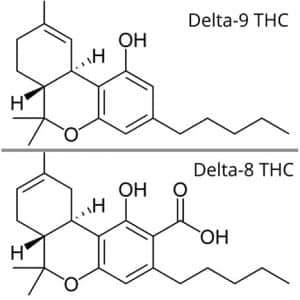Delta 8 (Delta-8-tetrahydrocannabinol), although it has been overshadowed in the past few decades, is the fourth most researched cannabinoid. It is also known as Delta 8, D8, delta-8 or delta-8-THC. Recently, some facilities have begun synthesizing Delta 8 from CBD. The number “8” refers to the placement of a chemical bond, so Delta 8 and Delta 9 are structurally similar. Delta 8 can be derived from cannabis or hemp plants but is rarer than Delta 9. A common process is for CBD to be extracted from hemp, refined into an isolate and then synthesized into Delta-8.

Both Delta 8 and Delta 9 are psychoactive and chemically alike. Delta 8 has a lower psychotropic impact than Delta 9, which means it will not impact the “mental state” or nervous system as much as Delta 9. Research, so far, has concluded that Delta 8 is about half as strong as Delta 9. Unlike Delta 9, Delta 8 is not easily oxidized to become a cannabinol and has a prolonged shelf life.
CB1 receptors and CB2 receptors, which are a part of the endocannabinoid system, receive and transduce signals to the body. Delta 9 acts on the CB1 receptors that are primarily found in the nervous system, but Delta 8 acts on both the CB1 and CB2 receptors. Therefore, Delta 8 has the potential to impact more systems in the body than Delta 9.
Delta 8 has been recently acknowledged because of the 2018 farm bill, which legalized the distribution of products derived from industrial hemp and have a content of under 0.3% THC. This includes delta-8-THC that is produced from industrial hemp. The Agricultural Improvement Act of 2018 made hemp derived delta-8-THC 100% legal, so Delta 8 is the first federally legal THC product!

